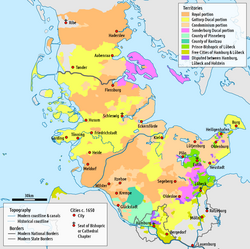This article has multiple issues. Please help improve it or discuss these issues on the talk page . (Learn how and when to remove these messages)
|
County of Holstein-Pinneberg County of Schauenburg and Holstein-Pinneberg | |||||||||
|---|---|---|---|---|---|---|---|---|---|
| 1290–1640 | |||||||||
 Holstein-Pinneberg and neighbouring territories around 1400 | |||||||||
| Status | Imperial county | ||||||||
| Capital | Pinneberg | ||||||||
| Common languages | Northern Low Saxon, German | ||||||||
| Religion | Rom. Catholic to 1561, then mainly Lutheran, Calvinist from 1601 and Jewish from 1621, esp. in Altona | ||||||||
| Government | Monarchy | ||||||||
| Counts of Schauenburg | |||||||||
| House of Schauenburg | |||||||||
| Historical era | Middle Ages | ||||||||
| 1290 | |||||||||
• Usurpation in 1640 after the comital male line died out | 1640 | ||||||||
| |||||||||
| Today part of | Germany | ||||||||
The County of Holstein-Pinneberg (German : Grafschaft Holstein-Pinneberg), also known as the County of Schauenburg and Holstein-Pinneberg (German : Grafschaft Schauenburg und Holstein-Pinneberg), was a small territory which existed from 1290 until 1640, centred around Pinneberg in modern-day Schleswig-Holstein, Germany. [1]


